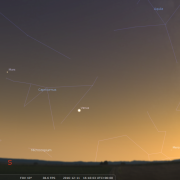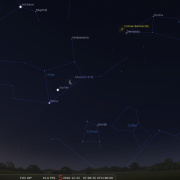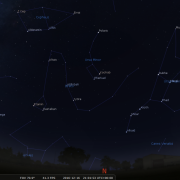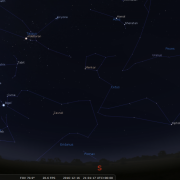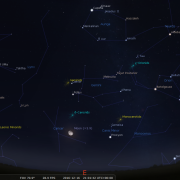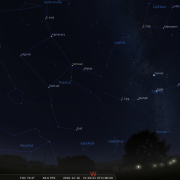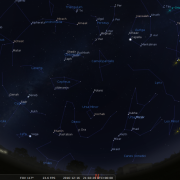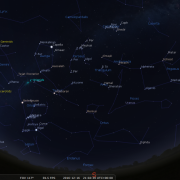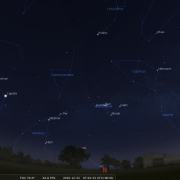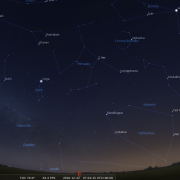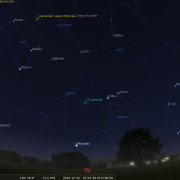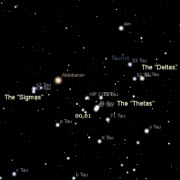Welcome to the WDAS monthly newsletter for December 2016: a digest of the month's latest contributions to our website. Below you'll find Society News, Sky Notes and In-Focus articles printed in full. There's also future events, and trailers for other articles which appear in full on the website - just a click away!
On the website you'll also be able to comment on articles, and if you'd like to play an editorial role in creating new content, just let us know!
Society News
Hi Everyone! I'm Andi. Some of you know me from the WDAS monthly meetings or Star Parties, but the WDAS Newsletter reaches a wider audience. I'm also part of your Newsletter team with Mark and Héctor. Héctor created this amazing website for you and he makes the newsletter work. Mark writes most of the articles for your pleasure and education, while I publish them on the web. But this article I'll write myself, because I want to introduce some regular new content to the WDAS website and ask you to consider supporting the work.
I'm not sure how many readers have watched Science and Astronomy content on YouTube, but it has to be the best place to learn on the planet. Hidden within the rants, product reviews, pranks and comedy; many wonderful and dedicated people are devoted to making superbly researched and produced educational videos. Here are a few of my favourite channels:
- Minute Physics: theoretical physicist Henry Reich explains fascinating and mind-bending facts about Science and the Universe short animations. And Henry's colleagues make a sister channel, Minute Earth.
- Fraser Cain: publishes the best on-line news source for Astronomers: "Universe Today", and his YouTube channel explains aspects of Astronomy every week.
- Deep Sky Videos: one of several channels made by Brady Haran and Astronomers & Physicists at Nottingham University. This channel has fascinating stories about Messier objects and tours of the world's biggest telescopes.
- PBS Space Time: favourite of hard-core cosmology fans, this channel is the place to be if you want to really understand how the Universe works as Einstein did.
These channels are labours of love and dedication by their intrepid creators, whose dedication in teaching the world can be a full-time job. They can only do their great work with some financial support. And the best way the internet has so far found to do that is to for some of the millions who benefit from the knowledge to make some trivial monthly contribution. All these content creators fund themselves (in whole or part) through a scheme called "Patreon". Here's the deal: a few hundred people who give a dollar or two per month (sorry, yes, it's always in dollars) can support science education viewed by millions. It's a trivial contribution, yet if we don't throw the odd coin in the hat, that great education resource will be snuffed-out.
Well, here's some great news: there are plenty of science-fans to spread around support so we can choose a channel or two to support.

UK Astrophysicist Sebastian
Pines, creator of 'Astronomic'
YouTube channel.
I'm going to make a case for some WDAS Members to support a new channel called 'Astronomic' by a young British Astrophysicist called Sebastian Pines. Here's a chance to make a big difference, because Seb has the great skill of explaining stellar mysteries in a stream of succinct videos. It takes lots of time to build up a support base, and unlike the channels I mentioned that already have hundreds of supporters, Astronomic is just starting out. You can check out some of his videos... I listed just a few of them below:
- Can we see black holes?
- What are brown dwarfs?
- Where did the Big Bang happen?
- Can a moon have a moon?
- Why is the Sunset red?
- Why is the earth round?
- Do galaxies die?
- Schrodinger
By supporting 'Astronomic', you'll get to see how Sebastian develops the channel, and you can have your name listed as a supporter on his videos! I'm also going to post one or two of the Astronomic videos on WDAS each month, which will be included in the newsletter along with the video transcript. So it's kind of a way to support WDAS too!
If you're up for that, here's a link to Astronomic's Patreon page.
This month's video from Astronomic...
In theory, a moon can have a moon. The region of space around a satellite where a sub-satellite can exist is called a 'Hill sphere'. Outside the Hill sphere the sub-satellite would be lost around the satellite, and therefore orbiting the planet or the sun instead of the moon itself.
An easy example of this is the Sun, Earth, Moon system. Earth is a satellite of the Sun, and the Moon is a sub-satellite of the Earth. The Moon orbits the Earth because the earth is about 380,000km (237,000 miles) from the Earth. This is well within the Hill sphere of the Earth, which has a radius of 1.5m km.
The Hill sphere is basically the space where Earth's gravity is more important than the Sun's gravity to another object. If the Moon somehow ended up outside the Hill sphere of the Earth, the Moon would orbit around the Sun instead of the Earth - just like all the other planets, asteroids and comets.
Jupiter's Hillsphere is much larger than the Earth. That's partly because it has more mass and more gravitational gravitational pull, but especially because it is further away from the Sun, so the Sun's gravity is much weaker at Jupiter than at Earth. This Jupiter a much bigger gravitational influence - one reason why Jupiter has a lot of moons. Not only has it got a big Hill radius, but it's also far enough from the Sun to have its own gravitational dominance.
So if we look at the Earth's Moon, it could have a sub-satellite. The Moon has its own Hill sphere with a radius of 67,000km (37,000 miles). This is where the sub-satellite could exist. If an object lies outside of the Hill sphere of the Moon it would therefore orbit the Earth instead of the Moon.
The only problem is that the sub-satellite cannot stay in orbit around the Moon because of tides. Like almost all the moons in the solar system, our Moon has a synchronous rotation (ie. they have the same face to their planet at all times). This results on tidal forces between the Earth and Moon... the same tidal forces that cause high/low tides on Earth. So any sub-satellite orbiting the Earth would have its orbit decay until eventually the sub-satellite would crash into the Moon or until be pulled apart by the Moon's tidal forces.
But in principle, the maths show that a Moon can have a Moon as long as certain
conditions are met.
 As of going to press, 8 people have so far booked for the society Christmas meal at the Hare and Hounds on Friday 9th. Menus choices must be made by December 6th - the night of our monthly meeting, which is the cut off date for anyone wishing to book a seat at the festive table. Travelling arrangements will be finalised then. The meal has been provisionally booked for 19:30h. The menu is on the website. If you could let Mark your choices as soon as possible it would be much appreciated.
As of going to press, 8 people have so far booked for the society Christmas meal at the Hare and Hounds on Friday 9th. Menus choices must be made by December 6th - the night of our monthly meeting, which is the cut off date for anyone wishing to book a seat at the festive table. Travelling arrangements will be finalised then. The meal has been provisionally booked for 19:30h. The menu is on the website. If you could let Mark your choices as soon as possible it would be much appreciated.
May 9th has been pencilled in for Paul’s lecture. The topic has yet to be decided, and the venue, but apart from that everything is going to plan.
We have been invited once again to assist with the Schools star night activities. The event is some way off, but the date for the diary is March 22nd – 19:00h. The York planetarium will be present, and hot soup, rolls and cakes will be available. Should be a good evening!
Five society members, Andi, Andy, Lee, Mark and John from Westerdale made the journey over to Leeds Astromeet this year. With Andi at the helm, we seemed to make good time, arriving at the venue with almost half an hour to spare before the first lecture. Parking proved more complicated than usual, with free ‘on street’ parking, off limits, replaced by ‘not so free’ ‘round the back’ car parking, admittedly at a reduced ‘coded’ rate to those attending the Astromeet.
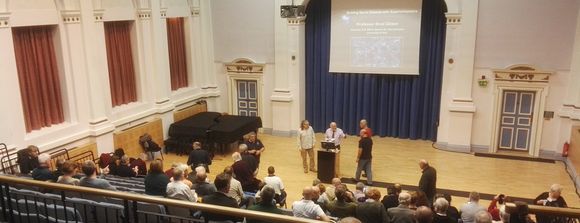
Once inside the hall there was time enough to peruse the trade rooms. Two minutes later...yes, it has to be said, traders were sparse, somewhat disappointing, but on the other hand several purchases were made before the first lecture, real bargains too!
The lectures themselves will be covered in the January issue, suffice to say there was general agreement in the car on the way back, that they were better than last year, causing great debate amongst us.
As usual, dinner was spent in the student’s union complex. Construction work was very evident wherever we went. Leeds Uni is currently undergoing a £520 million pound facelift and expansion. Fortunately the cost of dinner hadn’t gone up to help pay for this, it came in at around a fiver.
The afternoon session seemed to fly by, especially for anyone who nodded off. As is customary Dr Alan Chapman drew the raffle before his talk. Prizes were not as bountiful or generous due to the lack of traders, however of the eight or so prizes on offer Andi/Andy won two, Mark won another and we almost won a further two, one number out. In fact most of the numbers drawn were between 990 and 1000, mirroring the numbers of our tickets.
Slightly embarrassing, our row was up and down like a yoyo. Our loot included a 3.2mm Bader eyepiece, a book, which bizarrely Mark had already bought earlier, and a disk about the Higgs Bosson particle. How strange?
The homeward journey was plagued by fog, which grew ever denser as we neared, and then passed Pickering. Fortunately, on reaching Saltersgate we ran out of it, and skies cleared somewhat. Another astromeet done and dusted, let’s hope that next year more traders attend.
Cosmology Corner
In theory, a moon can have a moon. The region of space around a satellite where a sub-satellite can exist is called a hillsphere. Outside the hillsphere the sub-satellite would be lost around the satellite, and therefore orbiting the planet or the sun instead of the moon itself.
An easy example of this is the Sun, Earth, Moon system. Earth is a satellite of the Sun, and the Moon is a sub-satellite of the Earth. The Moon orbits the Earth because the earth is about 380,000km (237,000 miles) from the Earth. This is well within the Hillsphere of the Earth, which has a radius of 1.5mkm.
A Hillsphere basically defines as the space where the Earth's gravity is more important than the Sun's gravity to another object. If the Moon somehow ended up outside the Hillsphere of the Earth, the Moon would orbit around the Sun instead of the Earth - just like all the other planets, asteroids and comets.
Jupiter's Hillsphere is much larger than the Earth. That's partly because it has more mass and more gravitational gravitational pull, but especially because it is further away from the Sun, so the Sun's gravity is much weaker at Jupiter than at Earth. This Jupiter a much bigger gravitational influence - one reason why Jupiter has a lot of moons. Not only has it got a big Hill radius, but it's also far enough from the Sun to have its own gravitational dominance.
So if we look at the Earth's Moon, it could have a sub-satellite. The Moon has its own hillsphere with a radius of 67,000km (37,000 miles). This is where the sub-satellite could exist. If an object lies outside of the Hillsphere of the Moon it would therefore orbit the Earth instead of the Moon.
The only problem is that the sub-satellite cannot stay in orbit around the Moon because of tides. Like almost all the moons in the solar system, our Moon has a synchronous rotation (ie. they have the same face to their planet at all times). This results on tidal forces between the Earth and Moon... the same tidal forces that cause high/low tides on Earth. So any sub-satellite orbiting the Earth would have its orbit decay until the sub-satellite crashed into the Moon or until it was pulled apart by the Moon's tides.
But in principle, the maths show that a Moon can have a Moon as long as certain
parameters are obeyed.
Sky Notes
In this month's Sky Notes:
Planetary Skylights
 Here’s a planetary observing challenge, during the first half of the month elusive Mercury makes a half hearted appearance in the evening twilight, very low in the SW sky. The optimum dates to spot Mercury are from the 9th to the 19th, shortly after 16:00h, but you will require an unobstructed horizon as mercury will be no more than 3 or 4 degrees above it at best - if you observe just over half an hour after sunset. On the 11th Mercury reaches greatest eastern elongation, approximately 18 degrees or just over a hands span (arm’s length) to the left of the Sun, but still just a few degrees above the horizon. Once tracked down (using binoculars if required) you should be able to pick it out of the twilight with just the naked eye, but you will have to be sharp. Good hunting.
Here’s a planetary observing challenge, during the first half of the month elusive Mercury makes a half hearted appearance in the evening twilight, very low in the SW sky. The optimum dates to spot Mercury are from the 9th to the 19th, shortly after 16:00h, but you will require an unobstructed horizon as mercury will be no more than 3 or 4 degrees above it at best - if you observe just over half an hour after sunset. On the 11th Mercury reaches greatest eastern elongation, approximately 18 degrees or just over a hands span (arm’s length) to the left of the Sun, but still just a few degrees above the horizon. Once tracked down (using binoculars if required) you should be able to pick it out of the twilight with just the naked eye, but you will have to be sharp. Good hunting.
 Venus on the other hand should be much easier to spot, a brilliant beacon low above the SW horizon. As we head through December, Venus gains a little in altitude, and therefore prominence, masquerading as the ‘Christmas star’ over the festive period. Telescopically Venus exhibits a distinct half phase, although no other detail is visible due to the constant duvet of obscuring cloud. View on the 3rd when a slim crescent moon lies directly above Venus.
Venus on the other hand should be much easier to spot, a brilliant beacon low above the SW horizon. As we head through December, Venus gains a little in altitude, and therefore prominence, masquerading as the ‘Christmas star’ over the festive period. Telescopically Venus exhibits a distinct half phase, although no other detail is visible due to the constant duvet of obscuring cloud. View on the 3rd when a slim crescent moon lies directly above Venus.
 Jupiter;- the only other bright planet readily visible, resides in the dawn sky, in which it reigns supreme. Look for it by 03:00h over in the east, or better still wait until later in the month observing around 7am at which time Jupiter will lie due south, not far above the bright star Spica in Virgo. Telescopically Jupiter is always a treat to view; even smaller instruments reveal the banding across the disc and the Galilean satellites. . The moon lies nearby on the 22/23rd.
Jupiter;- the only other bright planet readily visible, resides in the dawn sky, in which it reigns supreme. Look for it by 03:00h over in the east, or better still wait until later in the month observing around 7am at which time Jupiter will lie due south, not far above the bright star Spica in Virgo. Telescopically Jupiter is always a treat to view; even smaller instruments reveal the banding across the disc and the Galilean satellites. . The moon lies nearby on the 22/23rd.
 Mars also resides in the SW twilight sky, located upper left of Venus, its ‘ruddy’ hue a giveaway. With the distance to the Red planet increasing daily, it appears quite small and disappointing through a telescope with little surface detail visible to the untrained eye. The crescent moon resides between Mars and Venus on the 5th and above Mars the following evening.
Mars also resides in the SW twilight sky, located upper left of Venus, its ‘ruddy’ hue a giveaway. With the distance to the Red planet increasing daily, it appears quite small and disappointing through a telescope with little surface detail visible to the untrained eye. The crescent moon resides between Mars and Venus on the 5th and above Mars the following evening.
 Neptune, the faintest of the planets and visible only in a scope is involved in several conjunctions before it finally departs the sky. On Dec 6th it is actually occulted by the moon as they set around 22:30h. Depending on conditions we may try and spot Neptune near the moon after our meeting. Then on the very last day of the year Neptune and Mars are separated by less than half a degree. View around 18:30h across in the SW. Neptune will appear as a tiny blue/grey disk.
Neptune, the faintest of the planets and visible only in a scope is involved in several conjunctions before it finally departs the sky. On Dec 6th it is actually occulted by the moon as they set around 22:30h. Depending on conditions we may try and spot Neptune near the moon after our meeting. Then on the very last day of the year Neptune and Mars are separated by less than half a degree. View around 18:30h across in the SW. Neptune will appear as a tiny blue/grey disk.
Meteor Showers

Meteor activity reaches a peak at this time of year and given clear skies the chance of spotting a shooting star or two is quite high. It is a pity therefore that the best shower of December, the Geminids, now considered to be the most prolific annual shower, is severely hampered by light from the full moon. The Geminids are active from December 7-16, reaching a peak on December 14th.
Geminids originate from debris shed by a small asteroid called Phaethon, which may even be the nucleus of a ‘dead’ comet. Phaethon passes within 10 million miles of the Sun causing the object to deposit material over great swathes of the inner solar system. However it is only within the last 100 years that Geminid activity has increased to the levels now recorded, a result of Earth passing through a much denser debris strand, a situation that will only last another 100 years!
Typical Geminids are about the size of a large coffee granule and penetrate deep into Earth’s atmosphere before ‘burning up’ - (two processes; known as ablation and ionisation) Brighter Geminids regularly produce long luminous trails, sometimes green or orange in hue. The shower radiant lies close to Castor, visible in the east by 21:00h. Under ideal conditions the Zenith Hourly Rate (ZHR) can reach well over one hundred meteors, however observed rates are always substantially lower and the full moon will drown out all but the brighter ones this year. Observing in the pre-dawn skies on the 14th will afford the best chance of spotting Geminids.
If clear, conditions should be better for the much less prolific Ursid meteor shower. The shower is active from Dec 17-25th, peaking on Dec 22/23rd. Hourly rates of 8-12 are normal, however occasionally, and erratically, Ursids produce strong outbursts as has been the case in the last few years. The radiant lies close to the Great Bear- up in the NE.
Winter Solstice
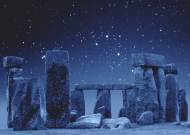 The Sun reaches its lowest position in the sky on December 22nd this year; the date of the winter solstice, by which time the Sun arcs little more than 12 degrees above the South horizon at local noon from our latitude. With the northern hemisphere tilted away from the Sun, useful daylight amounts to just 7½ hrs, the shortest day.
The Sun reaches its lowest position in the sky on December 22nd this year; the date of the winter solstice, by which time the Sun arcs little more than 12 degrees above the South horizon at local noon from our latitude. With the northern hemisphere tilted away from the Sun, useful daylight amounts to just 7½ hrs, the shortest day.
Latest sunrise and earliest sunset do not however occur on the winter solstice date. The Sun rises latest near the end of December (27 or 28th) and sets earliest mid-month (15 or 16th). Astronomically speaking the winter solstice also marks the first day of winter in the northern hemisphere, but within a few weeks daylight will once again start to lengthen in duration. Now that must be cause for celebration! What shall we call it...errr, Easter?
December 2016 Sky Charts
Click each image to see a full-size Sky Chart:
Additional Image Credits:
- Planets and Comets where not otherwise mentioned: NASA
- Sky Charts: Stellarium Software
In-Focus
In the first of this two-part feature we shall take a look at some of the celestial winter wonders located in or near the asterism sometimes referred to as the Celestial “G”, whether using the naked eye, binoculars or a telescope.
But first let us familiarise ourselves with the celestial “G”. This large asterism encompasses much of the southern aspect of the winter sky, incorporating the brightest stars visible there, which form a large, slightly tilted in aspect, capital letter ‘G’.
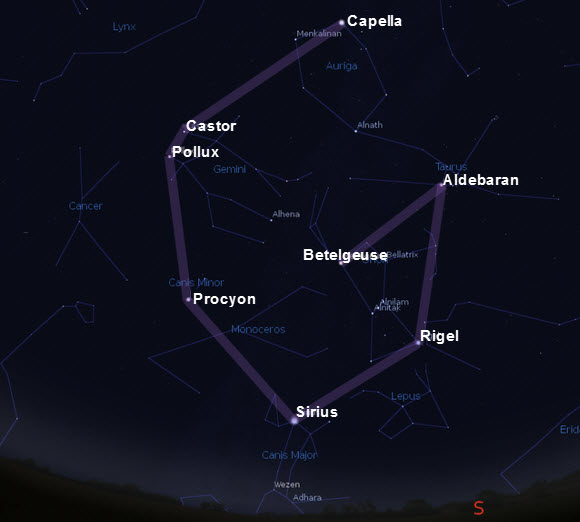
The Celestial G, connecting Aldebaran, Capella, Castor and Pollux,
Procyon, Sirius, Rigel and Betelgeuse.
We shall start at “ruddy” Aldebaran (the eye of the bull) high up in Taurus. Aldebaran appears to be a member of the “V” shape Hyades cluster, but is in fact a fake, lying at half the distance of the true members, which are approximately 120 light years distant.
Zeta Tauri and the Crab
Nebula (Image: ESA/Hubble)
The Hyades are a good example of a loose open cluster, and are best viewed through binoculars. Not far from the Hyades, the smaller, but more beautiful Pleiades open cluster really attracts attention. This cluster is a gem when viewed in binoculars and breathtaking if your scope comes with a really low power eyepiece. The Pleiades is a good example of a young star cluster – thought to be around 150 million yrs old, it lies 410 lys away.
Taurus also contains one of the very few supernova remnants visible to smaller instruments - the Crab nebula or M1. This remarkable object lies close to zeta Tauri – the southern horn, and is visible as a misty patch when viewed though a scope. In 1054 however, this cataclysmic stellar death briefly outshone all other objects in the sky and could be seen in daylight.
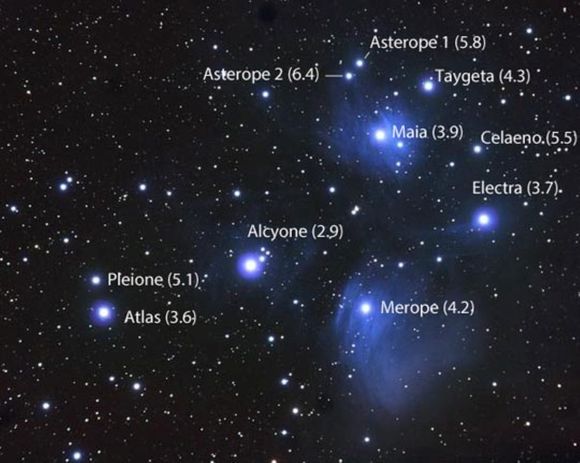
The Pleiades in Taurus
Return to Aldebaran and travel up to the zenith - the point overhead. The bright star visible is Capella in Auriga. This constellation contains 3 open clusters (M36, M37 & M38) all visible in binoculars but all are best viewed with a scope. All three are over 4,000 light years distant.

M36, M37 and M38, near Capella in Auriga
From Capella travel down in a S.E direction to locate the “twins” of Castor and Pollux, chief stars in Gemini.
Castor can be readily split into two components with most scopes, but it is a much more complicated system with at least 6 members comprising the star we see.
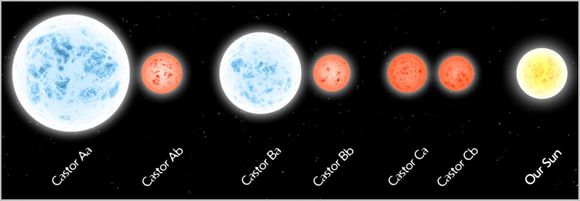
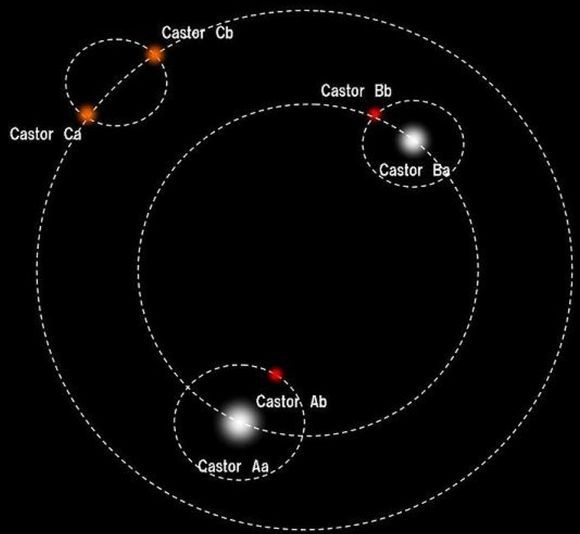
Castor System (bottom, image: unknown) and
the relative sizes of its components (top, Image: NASA Artist)
At the opposite end of the constellation, close to the star marking Gemini’s left foot (the uppermost as we look) resides one of largest open clusters visible, M35. Through binoculars it appears as a grainy haze of light, while in small scopes at low/med magnification it resembles a spectacular swarm of faint stars.
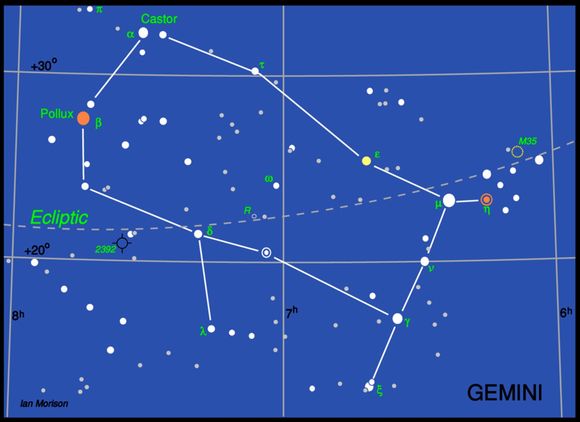
Gemini Finder Chart (Image: Jodrel Bank/University of Manchester)
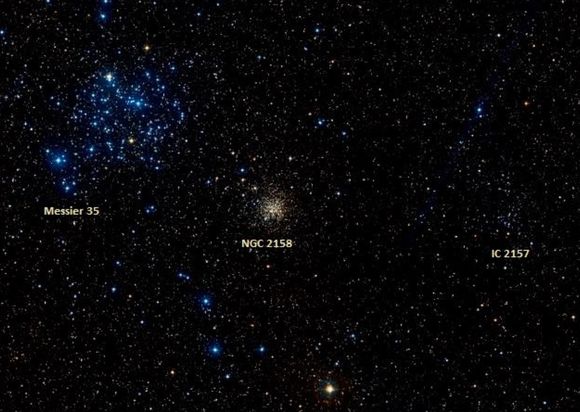
M35, NGC2158 and IC2157 in Gemini (Image: NASA)
Our next “G” star is Procyon the bright star below Gemini in the constellation of Canes Minor.
Procyon sits close to the Milky Way - the ribbon of light from countless stars marking a spiral arm of our galaxy. Sweep this area with binoculars or low power and you will be awe struck by the sheer number. Next hop across the milky stream and continue down to the S to find the brightest member of the “G” and the brightest star in the night sky - Sirius in Canes Major.
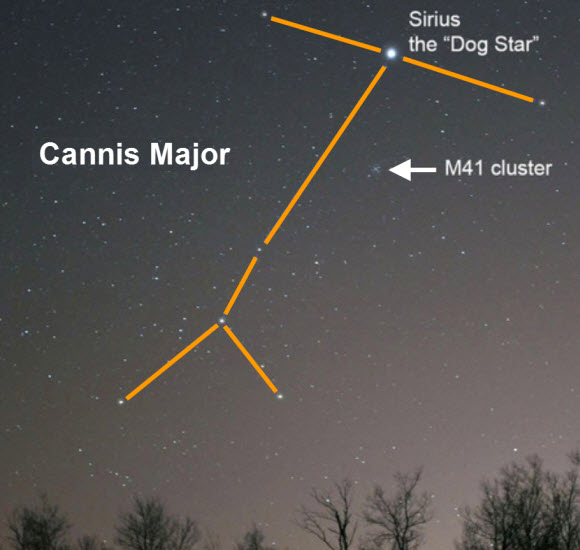
Sirius in Cannis Major, and the M41 Cluster (Image: Astro Bob)
Viewed through any instrument, Sirius resembles a dazzling diamond flashing all colours of the rainbow - no your optics are not faulty (hopefully) this is due to the turbulent, denser part of the Earth's atmosphere we all have to peer through. A binocular field below Sirius lies a beautiful open cluster M41 which is surrounded by a rich field of background stars.
Our last port of call is the majestic constellation of Orion. First travel across to brilliant blue-white Rigel at the foot of Orion - brightest of the many young massive stars found in this region which formed from the same giant molecular cloud tens of millions years ago. Now sweep up to the three belt stars of Orion, below which, in the sword of Orion sits a celestial marvel - the Orion nebula, M42. This huge nebulosity is our closest stellar nursery, some 1250 light years distant. At its centre sit the hot young massive Trapezium stars - the bully boys of this crèche.

Betelgeuse star placed at the centre of our Solar Sytem, showing orbits of the planets.
(Image: Karl Schwarz?)
This is one object worth viewing over and over again, use different powers to highlight different aspects. The nebulous extension of M43 lies just to the N of M42. Completing the “G” is the red super giant star Betelgeuse, marking the right shoulder of Orion. Betelgeuse is a behemoth of a star, perhaps 400million miles in diameter, but now extremely tenuous. It shines at the other end of the stellar evolutionary scale, a star whose life is heading towards an explosive finale sometime within the next 10,000 yrs. When Betelgeuse does go supernova, wow, will it be a sight to behold. Put it on your Christmas wish list!
Events
 Observe the night sky with us at the Bruce Observatory, Whitby School
Observe the night sky with us at the Bruce Observatory, Whitby School
Observing Nights are held weather permitting: check for a relatively clear sky before leaving home. If in doubt, Mark can be reached on 07886069339
Please note the college drive gate is now operated via a electronic key code - so anyone wishing to attend must be at the car park at the top of the drive by 19:00hrs - unless an arrival time has been arranged with Mark/Keith.
 Observe the night sky with us at the Bruce Observatory, Whitby School
Observe the night sky with us at the Bruce Observatory, Whitby School
Observing Nights are held weather permitting: check for a relatively clear sky before leaving home. If in doubt, Mark can be reached on 07886069339
Please note the college drive gate is now operated via a electronic key code - so anyone wishing to attend must be at the car park at the top of the drive by 19:00hrs - unless an arrival time has been arranged with Mark/Keith.
 Whitby School - Room H1.
Whitby School - Room H1.
In Members' monthly meetings we usually take a tour of the night sky for the coming month using the Planetarium program. Have talks and presentations on various topics of astronomy/space etc, and discuss future events etc. New members welcome.


